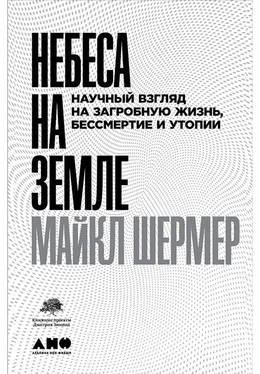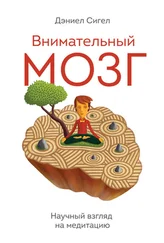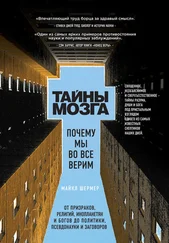Я написал о своей матери очерк под названием «Царство теней». См.: Shermer, Michael. Science Friction. — New York: Henry Holt, 2005, pp. 101–109.
Nuland, Sherwin B. How We Die: Reflections on Life’s Final Chapter. — New York: Random House, 1993.
Slaughter, V., and M. Griffiths. «Death Understanding and Fear of Death in Young Children». Clinical Child Psychology and Psychiatry, 12 (4), 2007, pp. 525–535.
Bering, Jesse M., and David F. Bjorklund. «The Natural Emergence of Reasoning about the Afterlife as a Developmental Regularity». Developmental Psychology, 40 (2), 2004, pp. 217–233.
Разработка шаблона обращения с детьми, потерявшими близких, не является моей задачей, в этом качестве я рекомендую кн.: John James and Russell Friedman, When Children Grieve (New York: Harper Collins), а также обширные ресурсы возглавляемого авторами Grief Recovery Institute: http://bit.ly/1VsBW7f. См. также: Speece, Mark W. «Children’s Concepts of Death». Michigan Family Review, 01/1, 1995, pp. 57–69.
James and Friedman, When Children Grieve, p. 227.
Обзор литературы см. в: Corr, Charles A., and Donna M. Corr (ред). Handbook of Childhood Death and Bereavement. — New York: Springer, 1996.
Slaughter and Griffiths, 2007.
Shtulman, Andrew. Scienceblind: Why Our Intuitive Theories About the World Are So Often Wrong. — New York: Basic Books, 2017, p. 146.
Reiss, Diana. The Dolphin in the Mirror: Exploring Dolphin Minds and Saving Dolphin Lives. — New York: Mariner Books, 2012.
Alves, F., C. Nicolau, A. Dinis, C. Ribeiro, and L. Freitas. «Supportive Behavior of Free-Ranging Atlantic Spotted Dolphins (Stenella frontalis) Toward Dead Neonates, with Data on Perinatal Mortality». Acta Ethologica. doi:10.1007/s10211-014-0210-8, 2014.
Цит. по: Bates, Mary. «Do Dolphins Grieve?» Wired, 26 Jan, 2015. http://bit.ly/1JuVBeg.
Цит. по: Hooper, Rowan. «Death in Dolphins: Do They Understand They Are Mortal?» New Scientist, 31 Aug, 2011. http://bit.ly/1pTwkGe.
Там же.
Личная переписка, 21 декабря, 2016. См. также: McComb, Karen, Lucy Baker, and Cynthia Moss. «African Elephants Show High Levels of Interest in the Skulls and Ivory of Their Own Species». Biology Letters, 2 (1), 2006, pp. 26–28.
Moss, C. Elephant Memories: Thirteen Years in the Life of an Elephant Family. — New York: Fawcett Columbine, 1988.
См., напр.: Masson, Jeffrey M., and S. McCarthy. When Elephants Weep: The Emotional Lives of Animals. — New York: Delacorte Press, 1995; Boehm, C. Hierarchy in the Forest: The Evolution of Egalitarian Behavior. — Cambridge, MA: Harvard University Press, 1999; Ridley, M. The Origins of Virtue: Human Instincts and the Evolution of Cooperation. — New York: Viking, 1997.
Личная переписка, 17 апреля, 2016. К сожалению, вскоре после нашего обмена письмами у Рассела был обнаружен рак; он умер в ноябре 2016 г. Он был моим другом и коллегой, которого мне всегда будет не хватать.
Solecki, Ralph S. «The Shanidar IV, a Neanderthal Flower Burial in Northern Iraq». Science, 190 (4217), 1975. pp. 880, 881.
Sommer, Jeffrey D. «The Shanidar IV ‘Flower Burial’: A Re-evaluation of Neanderthal Burial Ritual». Cambridge Archaeological Journal, 9 (1), 1999, pp. 127–129.
Rendu, William et al. «Evidence Supporting an Intentional Neandertal Burial at La Chapelle-aux- Saints». PNAS, 111 (1), 2013, pp. 81–86. http://bit.ly/20Zxuka.
Zilhao, J., et al. «Symbolic Use of Marine Shells and Mineral Pigments by Iberian Neandertals». PNAS, 107 (3), 2010, pp. 1023–1028.
Duday, H. The Archaeology of the Dead. Lectures in Archaeothanatology. — Oxford: Oxbow Books, 2011.
Lieberman, Philip. Uniquely Human: The Evolution of Speech, Thought, and Selfless Behavior. — Cambridge, MA: Harvard University Press, 1991, p. 163.
Riel-Salvatore, Julien, and Claudine Gravel-Miguel. «Upper Paleolithic Mortuary Practices in Eurasia: A Critical Look at the Burial Record», 2013. В кн.: Sarah Tarlow and Liv Nilsson Stutz (ред.). The Oxford Handbook of the Archaeology of Death and Burial. — Oxford: Oxford University Press, pp. 303–346.
Trinkaus, Erik, Alexandra Buzhilova, Maria Mednikova, and Marvia Dobrovolskaya. The People of Sunghir: Burials, Bodies, and Behavior in the Early Upper Paleolithic. — Oxford: Oxford University Press, 2014.
Pettitt, Paul, Michael Richards, Roberto Maggi, and Vincenzo Formicola. «The Gravettian Burial Known as the Prince (‘Il Principe’): New Evidence for His Age and Diet». Antiquity, 77, 2003, pp. 15–19.
См. также: Tarlow, Sarah, and Liv Nilsson Stutz (ред.). The Oxford Handbook of the Archaeology of Death and Burial. — Oxford: Oxford University Press, 2013; Pearson, Mike Parker. The Archaeology of Death and Burial. — College Station: Texas A&M University Press, 2000.
Dirks, Paul H. G. M., Lee R. Berger, Eric M. Roberts, et al. «Geological and Taphonomic Context for the New Hominin Species Homo naledi from the Dinaledi Chamber, South Africa». eLife, 2015. http://bit.ly/1QLswxK.
http://reut.rs/1ZbdYML.
http://to.pbs.org/1UHoT08.
Shermer, Michael. «Murder in the Cave: Did Homo naledi behave more like Homo homicidensis?» Scientific American, 1 January, 2016.
Палеоантропологи пришли к выводу, что «целенаправленное погребение тела» — самое вероятное объяснение находки, после того как отвергли четыре другие гипотезы. Место проживания: в камере нет мусора, там очень темно, и для проживания потребовалось бы искусственное освещение, признаки которого отсутствуют, камера почти не доступна, и, судя по всему, доступ в нее никогда не был легким. Водный нанос: в затопляемых пещерах наблюдаются седиментологические слои грубообломочного материала, отсутствующего в камере Диналеди, где были открыты останки особей вида Homo naledi . Хищники: не обнаружены следы, оставленные хищниками на фрагментах скелетов, и останки самих хищников. Ловушка: судя по натечным отложениям на костях, останки скапливались здесь в течение продолжительного времени, что исключает возможность единичного катастрофического события, а почти полная недоступность камеры делает маловероятным многократное проникновение и гибель здесь отдельных особей.
Читать дальше
Конец ознакомительного отрывка
Купить книгу












